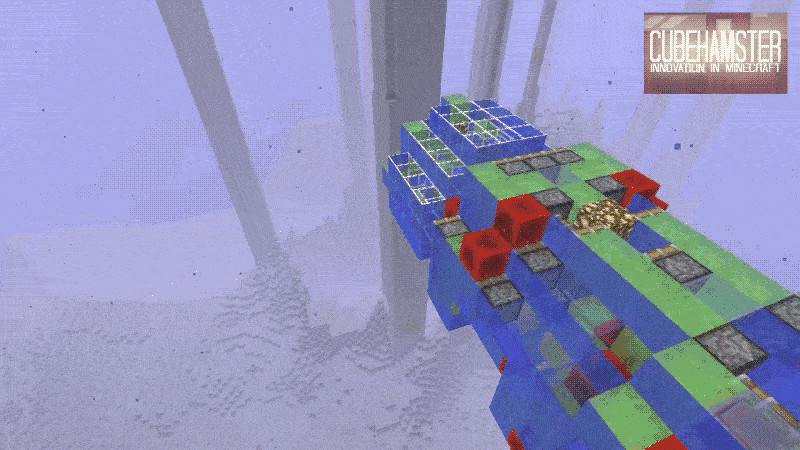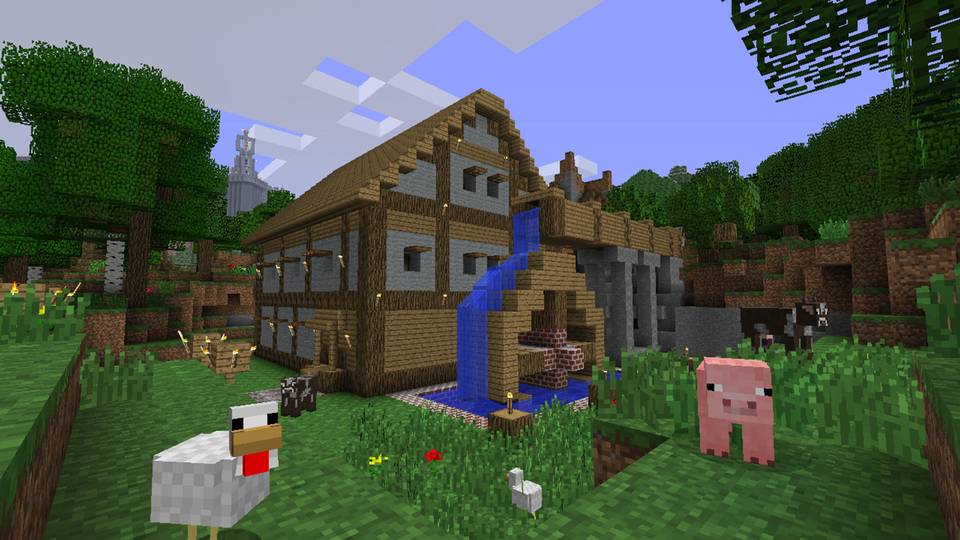
by Stone Marshall | Jan 13, 2016 | Minecraft News |
If your kid has been swept up in the “Minecraft” craze, you’ve probably come to realize that resistance is futile. It isn’t only the game itself that kids obsess over. There are Minecraft YouTube videos, “Minecraft”-like games, and lots more.
Here’s the know-how you need to engage with your kid on one of the coolest games out there.
A GUIDE TO THE “MINECRAFT” GAMES BY AGE
One of the best-selling, independently developed and published video games, Minecraft immerses kids in creative thinking, geometry, and even a little geology as they build imaginative block structures. Here’s the scoop on the games that make up “Minecraft’s” offerings:
_’Minecraft,’ age 8; platforms: Linux, Mac, Windows, Xbox 360
“Minecraft” is an open-ended, exploration- and creation-focused environment. Players can create items and buildings from scratch using materials they harvest from the world around them. Given carte blanche to sculpt virtually any creation of their choice in this 3-D space, kids can try tons of possibilities while working toward simple objectives. An option to work with others on larger building projects can help kids develop collaboration skills.
_’Minecraft-Pocket Edition,’ age 8; devices: iPhone, iPod Touch, iPad, Android, Kindle Fire
“Minecraft-Pocket Edition” is a mobile version of the popular PC game. Players can build essentially anything in this game, so long as they’re able to mine the appropriate resources.
‘Minecraft: Story Mode,’ age 10; platforms: Mac, Nintendo Wii U, PlayStation 3, PlayStation 4, PlayStation Vita, Windows, Xbox 360, Xbox One, iPhone
Though part of the fun of “Minecraft” is creating the story as you go along, “Story Mode” offers a storyline, characters, and plot for kids who prefer a narrative. This game offers positive messages about teamwork and diplomacy, and its learning curve isn’t as steep as the original.
‘MINECRAFT’ ON YOUTUBE
Since Minecraft is a game that spans many ages – and has infinite possibilities – not all YouTube videos will be appropriate for your kid. Here’s one of our faves for young players.
‘Wonder Quest’ (for age 6+)
This YouTube program is inspired by “Minecraft,” and its central character hails from creator Joseph Garrett’s other Internet hit, Stampylonghead. The videos do an excellent job blending comedy, adventure, and quality educational content under the premise of its heroes’ efforts to thwart a villain’s plan and return a collection of gems to their town. There are even social lessons that promote cooperation, kindness, and perseverance.
GAMES LIKE ‘MINECRAFT’
Because of its complexity, mild violence, and online community, we recommend “Minecraft” for kids age 8 and up. So what if your younger kids want to play but aren’t quite ready? These games can occupy them with a very similar style, without some of the tougher stuff.
‘Blox, 3D Junior,’ age 5
With a style similar to “Lego” and “Minecraft,” this app’s 3-D creation environment empowers kids to create, encourages visual acuity, and fosters critical thinking.
‘The Robot Factory,’ by Tinybop, age 6
This exploratory app for early elementary school-age kids is tailor-made for players who love to create, design, and experience free play.
‘Toca Builders,’ age 6
“Toca Builders” offers sandbox-style play where kids can create worlds. It’s easier to pick up and play than Minecraft, and there’s no fighting or monsters.
“Hovercraft – Build Fly, Retry,” age 7
Kids can learn about physics and problem solving as they design, test, and rebuild a hovercraft.
Common Sense Media is an independent nonprofit organization offering unbiased ratings and trusted advice to help families make smart media and technology choices. Check out our ratings and recommendations at www.commonsense.org.
Everything you need to know about ‘Minecraft’; a guide for all ages

by Stone Marshall | Jan 8, 2016 | Minecraft News |
It’s nearly Rift time! This is the year that Virtual Reality becomes the next big thing in videogames or at least embarrasses itself while trying to, like your drunk uncle trying to dance to Las Ketchup’s Asereje at your sister’s wedding reception.
Depending on who you talk to, Virtual Reality is wither the thing that’ll make games genuinely exciting again, or the most expensive video gaming gimmick, one that’s destined for catastrophic failure.
The very necessary head-mounted displays that’ll drive Virtual Reality are coming soon. Though HTC’s Vive was delayed to April, and PlayStation VR (along with its Wii-sized external processor) is expected at around the same time, we still have no idea when the frontrunner and progenitor of the current craze, Oculus’ Rift is out. Nor, critically, do we know what it’ll cost. For some though, it’ll cost nothing.
In one of the most generous bits of technological good will, Oculus has said that those who bought in to the original Rift Development Kit, backing it on Kickstarter in the early days, will be given a special Kickstarter Edition consumer headset for no extra cost. Like the standard consumer one, it’ll come bundled with two games; Lucky’s Tale and EVE: Valkyrie.
The caveat here though, is that you’ll have to reside in one of the twenty launch countries for the headset. As we in South Africa are so used to technological disappointment, it should come as no surprise then that we’re not one of those countries.
These are:
Australia, Belgium, Canada, Denmark, Finland, France, Germany, Iceland, Ireland, Italy, Japan, Netherlands, New Zealand, Norway, Poland, Spain, Sweden, Taiwan, United Kingdom and the United States.
“For those who don’t live in one of those 20 countries, we’re working on an alternative,” Oculus says – so you may yet be in luck.
Pre-orders for the Rift go live later today in those territories. We have no idea what it’ll cost or when it’ll ship.
According to the chaps at Superdata, the market for VR this year could reach $5.1 billion in 2016, and they suggest that the user base will reach 56 million in 2016. Before you roll your eyeballs so hard that they break free from the constraints of your skull, they do think that the majority of the market will be taken up by what they call “Light smartphone” VR.
“Initially, affordable smartphone devices will drive the bulk of sales as consumers first explore virtual reality before committing to the more expensive platforms,” said SuperData Director of Research Stephanie Llamas. “After this first wave, consumers will likely move more high-end VR devices on PC.”
Those who haven’t vomited themselves right out of existence thereafter would perhaps migrate towards the more expensive, premium VR tech that will soon be available; stuff like Vive, PlayStation VR and the Rift.
Oculus is giving early backers a consumer Rift for free
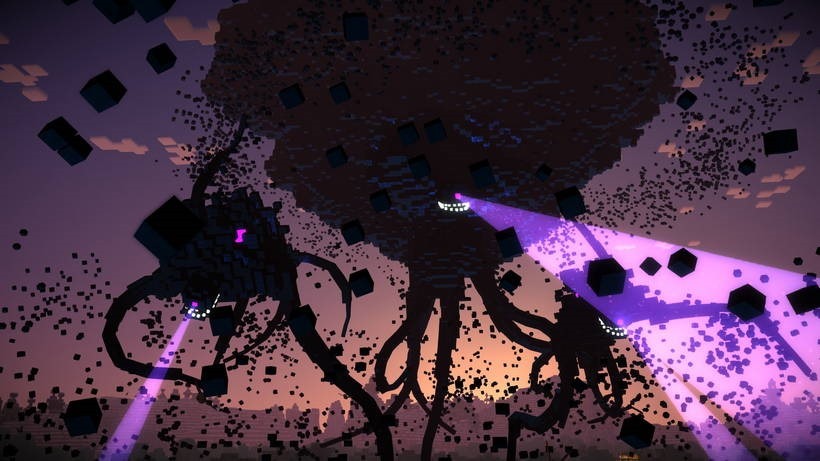
by Stone Marshall | Jan 8, 2016 | Minecraft News |
It was only in the third episode of Minecraft Story Mode that I actually started to care about the blocky characters I’d been barely controlling since I started playing this latest in Telltale’s increasing library of adventure games that are all largely the same. The Last Place You Look introduced something that resembled character development, and started to explore the bubbling frustrations that the group holds below the surface.
 \
\
There’s a bit more of that here, along with Telltale going for their signature one-two emotional punch that could leave particularly sensitive players, and the game’s intended younger audience distraught, on the brink of tears. The problem is that it feels both cheap and obvious – something that carries through in much of the rest of the episode.

When we last encountered Jesse and friends, they were well on their way to becoming the new order of the stone; a new set of heroes. Faced with a gargantuan Wither storm that just doesn’t seem to want to die, our friends and heroes start this episode escaping the aftermath of their unsuccessful attempt to destroy the black and purple beast that’s swallowing up the world and its denizens.
As has happened with just about every episode thus far, the adventure takes us to another wonderfully referenced are that ties in to Minecraft’s lore. This time, it sees our new heroes make their way to The Far Lands, which as Minecraft aficionados will tell you is where the limits of the game proper’s procedurally generated worlds.

It’s here that we learn about the true nature of the Order of the Stone. We learn why it is that some characters – like the much maligned Ivor who caused all of this mess I the first place – have been motivated in their actions and why the rest of the order are so damned insufferable. It’d be a great plot twist if it wasn’t so blindingly obvious thanks to the signposting that’s portended it all.
A bigger issue I’ve had is that it still doesn’t feel like my actions make all that much of a difference. Sure, some of my choices have led me to have different shiny, enchanted weapons, or given me slightly differing ways of finding my inside the pervasive wither storm – and maybe a choice or two about who I spend my adventuring time. Beyond that though, it really feels like all choices lead to the same outcome.

As far as gameplay goes, it’s more of the same, which is to be expected. A handful of QTE’s, a sprinkling of fisticuffs, some simple crafting and the usual barrage of timed dialogue choices. There’s also a bit of light puzzling that’s not too difficult if you pay attention to the dialogue, though it may flummox younger players. There is, however, a frustrating maze section that I feel has to be called out for its silliness; thanks to poor lighting and the perspective shown, it’s far harder to navigate than it really ought to be.
There’s something odd about this latest episode in Minecraft Story mode. The change in tone set by the last episode continues, and for a while is darker and sombre than a children’s game should be. And, by the end of it, it feels like the story’s come to a close, though there’s still another episode left. There’s very little that needs wrapping up, so I’m left suspecting that whatever happens in the last episode is little more than set-up for a second season. It’s either that or it’ll be odd padding for the sake of it, which would be a bit of misstep for Telltale.

Conclusion
A Block and a Hard Place isn’t a terrible episode – it’s certainly better than the fumbling second one – but it caps the adventure with a mild fizzle as opposed to the great big bang I’d been expecting. One of the biggest problems with it though, is that I don’t really care what happens in the concluding episode
7.0
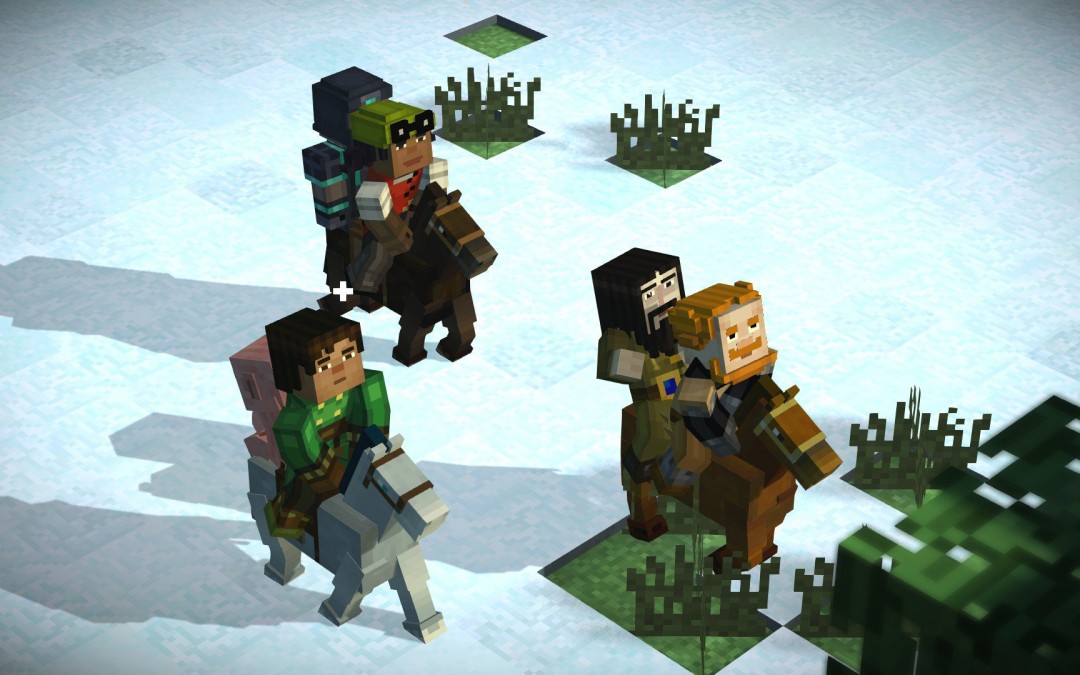
by Stone Marshall | Jan 7, 2016 | Minecraft News |
Denouement-craft
What a weird episode. After the high energy of The Last Place You Look, this one slows down the action shortly into it, and it doesn’t really pick back up until the very end, which feels like the end of a season. But then, there’s still another episode after this.
It’s hard to fault Telltale for switching up the formula a bit, but it feels like the first season is essentially complete at this point, and anything that could happen during the final episode will just be a lead-in to the next season. It might be better if this were just a four-episode series.

Minecraft: Story Mode: A Block and a Hard Place (iOS, Mac, PC [reviewed], PlayStation 3, PlayStation 4, PlayStation Vita, Wii U, Xbox 360, Xbox One)
Developer: Telltale Games
Publisher: Telltale Games
Released: December 22, 2015 (Mac, PC)
MSRP: $4.99, $24.99 (Season Pass)
Rig: AMD Phenom II X2 555 @ 3.2 GHz, with 4GB of RAM, ATI Radeon HD 5700, Windows 7 64-bit
Where the first two episodes in the season induced apathy, this one causes ambivalence. It’s a fine distinction: I was struggling to care about Jesse and his friends at first; now I care enough but find myself disappointed with the final result. For every beat Minecraft: Story Mode hits well, it stumbles once or twice.
On the one hand, the more deliberate progression of this episode can be a good thing. It opens up the gameplay to include actual (albeit easy) puzzles along with the standard dialogue trees and quick-time events. Also, without lulls in the action, it could be bombastic to the point of grating. If it’s always high energy, then it’s all the same.
On the other hand, the plodding of the first half of this episode is as dull as can be. There’s a horse travel montage near the beginning illustrating just how far it is to get to the Farlands, and protagonist Jesse has the option of the classic whine “Are we there yet?” Even with the cuts of the montage, I felt the same. I get it; it’s far. Let’s move on.
Once the action finally does pick up at the end, it still treads a questionable path. The full story about The Order of the Stone is revealed, and it plays out as foreshadowed. It’s always a little awkward when a story treats something like an earth-shattering reveal when most would see it coming from the hints in previous episodes. Perhaps if I had led the life Jesse did, it would have been more impactful.
Then, almost as if checking off all the Telltale boxes, we get another character death. This loss feels more important than the one in the third episode, since it’s a likable character. Death in children’s entertainment is nothing new (see: Bambi, The Land Before Time, Transformers [1986]), but it generally comes with a purpose. While we’ll have to wait for the fifth episode, my sneaking suspicion is the only reason this death was written in was a cynical attempt at eliciting emotion.
The really strange part of the whole scene is that in the middle of the mourning (when I have a full pout on my face), Story Mode lets loose a visual gag referencing the source material. Admittedly, it’s probably the funniest thing in the whole episode — so few of the jokes are worth even a chuckle — but it feels wrong to have it punctuate the rest of the sad scene so bluntly.

With the Wither Storm properly defeated, Jesse and the gang are proclaimed to be the new Order of the Stone, and A Block and a Hard Place ends with the vague promise of new adventures coming in the next episode. Unless it’s tightly written and self-contained, I’m not interested. More likely, the last episode will open up a can of worms that won’t get resolved until Season Two.
This episode could very well be considered the finale for the first season. It wraps up the Wither Storm saga, it answers the questions about the Order of the Stone, and it delivers a semi-happy, hopeful ending for the crew. If only it did that without an utterly boring first half and the clumsy insertion of mandatory Telltale story elements, it might have also been a good ending.
Review: Minecraft: Story Mode: A Block and a Hard Place
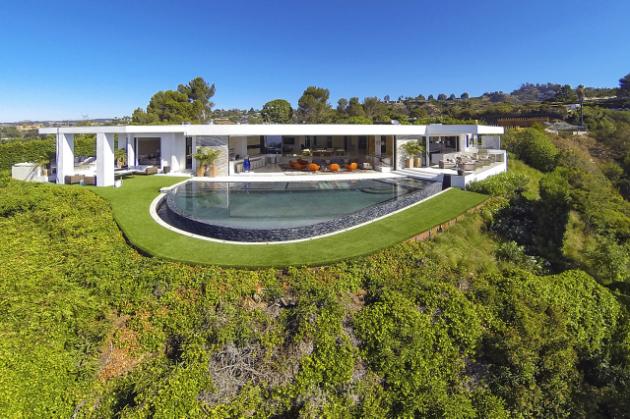
by Stone Marshall | Jan 7, 2016 | Minecraft News |
It seemed like an insane gamble: Spend millions upon millions of your personal fortune to build a house that’s so off-the-charts indulgent – $200,000 “candy wall,” $1 million-plus security system, quarter-million-dollar sculptures (plural) – that the Los Angeles Times won’t feel too hyperbolic declaring it “L.A.’s most extreme home.”
Then charge $85 million (£57m) for it and let the market have its way.
That the market certainly did. The 23,000-square-foot Beverly Hills gargantumansion notoriously sold a year ago for $70 million (£47m) — cash — to Minecraft founder Markus “Notch” Persson, a Swede who sold his Mojang game company to Microsoft and crossed into the billionaire club. Notch reportedly outbid Beyonce and Jay-Z.
Yahoo Real Estate spoke at length with Bruce Makowsky, the ultra-rich man who put a sizable chunk of his personal money and reputation on the line to build the spec house.
And we have to say, the way Makowsky explained his venture, we started to see his logic (though we wouldn’t have gambled our millions … lesson one, perhaps, in why we still don’t have any).
But first you had to think like a billionaire.
The property occupies just shy of an acre in Beverly Hills’ Trousdale Estates.
More Money Than Time
Makowsky had no problem thinking like a billionaire. He wasn’t one, but he wasn’t far off, members of his team told Yahoo Real Estate. He made his fortune in handbags and other women’s accessories, which you might have seen everywhere from QVC to Bloomingdale’s.
“I have a big mega-yacht and toys and planes,” Makowsky told us. “I kind of understand what very wealthy people want.”
Take yachts. (Bear with us, because this circles back to his real estate thinking.) He sat in the Beverly Hills gargantumansion with a prospective buyer who had a mutual interest in boats – who had, in fact, ordered up a 300-footer, at a cost of about $200 million (£136m). Makowsky asked how often the visitor sailed. About eight weeks a year, the visitor replied. The operating costs on that yacht were about $8 million (£5m) a year, or a million for each week of use.
Admittedly, we’re not sailors, but that seems mind-boggling: a boat that’s about twice as expensive as the most expensive mansion ever sold in America (and a mansion comes with land!).
What is so special about a $200 million yacht? we asked Makowsky.
He said that, in a nutshell, “every detail inside that boat is spectacular.” Every single detail. You don’t spend a couple hundred million on a yacht, hire a world-class chef and then tell a guest who wants pizza that you’re out of pepperoni, he said. On a billionaire’s yacht, you can’t ever be out of pepperoni; your fridge had better be big, and it’d better be stocked with every staple imaginable, plus some ingredients you’d barely dream of.
We’ll be honest. We weren’t entirely convinced that 24-hour personal pizzas equal $200 million of special. So he cited too the punishing saltwater, the unremitting barrage of ocean waves, the systems and craftsmanship required to keep the boat afloat.
As he spoke, though, it dawned on us that maybe the truth is something he can’t say out loud, at least not to a non-billionaire: Maybe yachts aren’t exactly $200 million worth of special, but to a billionaire, does that really matter?
“A lot of the wealthy people have more money than time,” he said, and “wealthy people are getting wealthier.”
There’s a backlog for mega-yachts that’s “incredible right now,” Makowsky told us. “I have a big boat – and I take it down to St. Bart’s and I’m the smallest boat in the marina.”
The Lure of the New
So you’re a billionaire, and you’ve spent $200 million on a yacht and $100 million on a jet and maybe a few million on your car collection. By now you may be making money almost faster than you can spend it: At a measly 1 percent interest, a billion dollars would generate $10 million a year.
Your real estate agent, meanwhile, keeps showing you houses that are $20 million, $30 million, maybe $50 million. They don’t knock your Cervelt socks off. Compared to the kind of money you’ve been spending, they might even seem a little, well, piddling.
And while 10,000 square feet may have been considered a big house a decade ago, that attitude has changed among the super-rich, who now demand “super-large,” Makowsky said. The mansion he built is more than twice that size.
There are “a lot of nice homes” out there, “but they’re tired,” he said. “Nothing brand-new.”
Is newness that important to the ultra-wealthy? we asked.
“They want to feel like they’re the first person in that house. … They want to feel like it’s theirs,” he said. That’s why, he said, he didn’t hold any open houses, or even one of the parties that’s become more common for high-end L.A. real estate. He wanted to preserve its untouchability.
Makowsky was emphatic. “People. Want. New.”
The natural conclusion might seem that they should build their own dream house, tailored to their tastes and desires. But remember to think like a billionaire who has more money than time. (And remember, too, that billionaires might easily own a dozen ultra-luxury properties at once; that’s how many homes most Americans have in a lifetime. As ultra-high-end developer Nile Niami says: “Nobody buys a 100,000-square-foot house as their principal residence to use every day.”)
They’d have to scout out the perfect lot – and in Los Angeles, promontories with downtown-to-ocean views are so coveted that a nearby family reportedly refused an offer of $75 million for their house, which developers intended to bulldoze. Then they’d have to get all the necessary local permissions and build the place. It takes “four to six years to do what we did here,” Makowsky said.
Not only that, they’d have to devote time and attention to all the hundreds of details that accumulate as luxury. On a yacht, luxury is made up of sea-hardiness, of masterful design in deceptively limited space, of laid-in pizza supplies. At the mansion Makowsky built, it’s mirrors placed so that wherever you are in the master bath, you can see downtown Los Angeles behind you, right down to the mirror backing within the medicine cabinet; it’s the drawers you open to discover they’re lined with crocodile; it’s “the most beautiful hangers” dangling in the closet.
Makowsky’s idea, in other words, was to “bring mega-yachts to land,” packaged up and ready to go, right down to the administrative staffing.
Which was an interesting proposition, because if billionaires were willing to spend $200 million plus $8 million a year on a boat they rarely used, what would their limit be for the right house?
‘The Air Is Absolutely Thin Up There’
The particular audacity of Makowsky’s venture is that the spec house Notch bought represented only Phase 1. Two more estates were in the works, and he said they’d be even more expensive. “I want to be like the Four Seasons of residential building,” he told us.
We think it’d take nerves of steel to build one spec house priced so high. How many billionaire prospects could there be?
“The air is absolutely thin up there,” he acknowledges, but he says 4,000 people worldwide are worth at least $500 million. Forbes counts a record 1,645 billionaires on the planet.
Meanwhile, brand-new, ultra-high-end houses like his are scarce. “Other than Donald Trump building something down in Palm Beach, this is the second-highest[-cost] spec house ever built in the United States.” We checked with Zillow, and only about 30 homes nationwide are publicly listed at more than $50 million. Just seven of them are asking $75 million or more. (Important caveat: This doesn’t include so-called “pocket” or “whisper” listings, or any other kind of off-market listing.)
So maybe Makowsky is onto something. His fellow L.A. developers sure seem to think so: Locally, there’s a bit of a stampede toward gargantumansions asking $100 million or more.
And one of them, Nile Niami, is expected to list a 100,000-square-foot spec house at half a billion dollars in the next year or so.
The Story Behind ‘LA’s Most Extreme Home’, Bought for $70M Cash by Minecraft Founder Notch
 \
\




